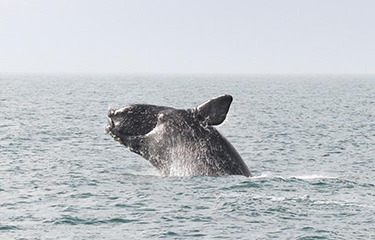Canadian commercial fishermen are hopeful ropeless gear could be a solution to address concerns of right whale entanglements in snow crab fisheries, and recent trials are showing that innovative technology can work along the East Coast of Canada.
New ropeless gear that eliminates the vertical lines that can entangle right whales is one possibility, and fishermen have had positive experiences with it in trials along the East Coast of Canada.
Ropeless gear stores the buoy at the bottom of the ocean until it’s released either by a special acoustic signal from a fishing vessel or a timer. Once the signal is received, the buoy quickly rises to the surface where it can be accessed by fishing crews with traditional gear.
“I would never imagine that I would use a smartphone for fishing,” Martin Noel, a snow crab fisherman with decades of experience, said at the Responsible Seafood Summit in Saint John, New Brunswick, Canada last month. “There’s a buoy at the bottom of the ocean just waiting for me to press the button, and then a minute after it pops up and I start fishing. So in the East Coast area where whales are present, you can fish crab while being safe for right whales.”
Fishermen were initially skeptical of the innovative gear, saying “ropeless is hopeless,” according to Noel.
The Canadian Wildlife Federation decided to begin trialing gear to see if ropeless solutions could be effective.
“We set out to develop a trial framework to determine how we could have an evidence-driven approach to testing the suitability of these devices for fisheries,” Canadian Wildlife Federation Fisheries Engagement Elizabeth Vezina said on the panel. “So we sat down with our fishing partners throughout the Maritimes and, you know, started to talk to them about what concerns they had with this gear, and of course, there were many.”
But during a demonstration in late 2019, Noel and others were surprised to see that the ropeless gear worked.
“Success changes perception,” Noel said.
The snow crab fishery continued limited trials with the acoustic devices in 2020, which Noel said was an overall success despite a few failures. By 2022, the number of vessels trialing ropeless gear had risen from 10 to 21. In 2024, the number of participants will expand to 30.
“That’s very exciting,” Noel said. “We have a very high rate of participation because it’s very interesting.”
The Canadian Wildlife Federation now has nine different gear systems in use and launched the CanFish Gear Lending Program in 2022 to provide ropeless gear to fishermen.
“There are many barriers to using this gear right now,” Vezina said. “It’s very high cost, and much of it is still in development.”
By making gear more accessible and providing training, CanFish is working to make adoption easier for commercial fishermen.
One of the big challenges for ropeless gear is coordination between fishermen, Noel said. Without visible markers on top of the water, it is possible for fishermen to lay gear over other fishermen’s gear, creating a dangerous situation. Noel said that they use a trap tracker to see where others are placing their gear and avoid them. There are other bugs that need to be worked out, he added, but they’re on the right path.
“That’s challenging, but we’re working on it,” Noel said.
“In principle, it sounds straightforward, but in reality, it’s not as straightforward,” Nova Scotia-based Ashored Innovations Chief Business Development Officer Stephen Jones said on the panel. “When you’re developing technologies for underwater, you have unique challenges that you don’t have in the air with land-based technologies.”
For example, an Ashored Innovations demonstration during the Responsible Seafood Summit failed due to a single bent lid bracket even though the acoustics and magnetic release worked perfectly.
“We spend a lot of time and energy making sure the reliability on the acoustic side is there, and sometimes it’s a very simple thing,” Jones admitted. “But that’s innovation.”
Photo courtesy of NOAA Fisheries







